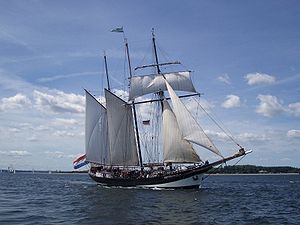- Oosterschelde (ship)
-

Career (Netherlands) 
Name: Oosterschelde Completed: 1918 General characteristics Length: 50 m Beam: 7,5 m Height: 36 m Depth: 2,95 m Installed power: Deutz 6 cylinder, 360 hp Sail plan: Schooner Capacity: room for 24 passengers Crew: 4 to 8 The Oosterschelde is a three masted schooner from the Netherlands, built in 1918. She is the largest restored Dutch freightship and the only remaining Dutch three masted topsailschooner, of which there were hundreds in the early 20th century. Her home port is Rotterdam.
As a freighter with a capacity of 400 tons, she transported mainly clay, stone and wood, but also herring, bran, potatoes, straw and bananas. In the 1930's a heavier diesel engine was installed and some sail-rigging was removed (including the aft mast). In 1939 she was sold to a Danish shipping company and, rebaptised Fuglen, became one of the most modern ships in the Danish fleet. In 1954 she was sold to a Swede, renamed Sylvan and thoroughly rebuilt to a modern motorised coaster.
In 1988 she was brought back to the Netherlands. She had always been maintained well, but restoration to the original state turned out too expensive for private funding. So a foundation collected money from various sources, partly by selling shares in the ship. Restoration lasted from 1990 to 1992, with the help of her last Dutch captain, Jan Kramer, and three maritime museums, to ensure authenticity.
From 1996 through 1998 she made a trip around the world. Maintenance is paid for through paying passengers and company presentations.
Specifications:
- Length: 50 m
- Width: 7,5 m
- Mast height: 36 m
- Depth: 2,95 m
- Sail surface: 891 m²
- Engine: Deutz 6 cylinder, 360 hp
- Crew: 4 to 8 (+ room for 24 passengers, up to 120 for daytrips)
- Huts: 8 x 2 person, 2 x 4 person
See also
External links
Categories:- Schooners
- Three-masted ships
- 1918 ships
Wikimedia Foundation. 2010.
